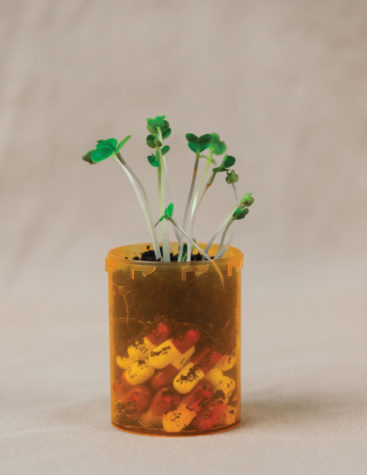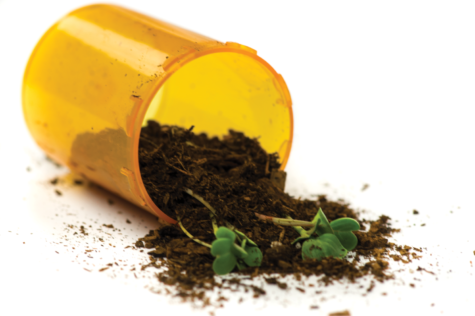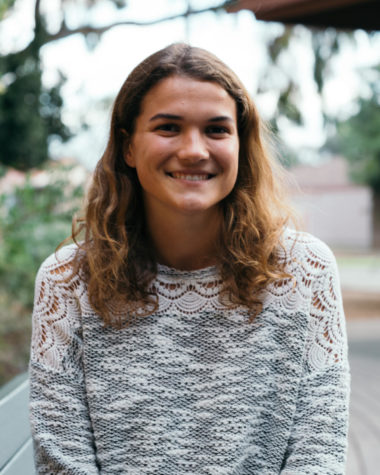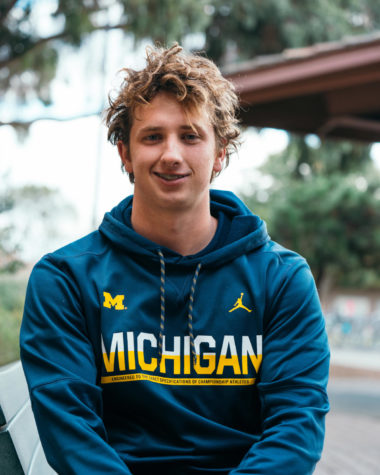Plants & Prescriptions
C Magazine compares and contrasts the different methods of medicine and healing.

An overwhelming stomach ache can be quickly, and effectively, alleviated with a Tums tablet, which tends to be at close reach in many homes. Brands as familiar as Tums have integrated themselves into the lives of many Americans, and in turn these companies have created a booming industry. The heavy reliance on Big Pharma is clearly seen through the seventy percent of Americans who take at least one pharmaceutical drug. In a way, people have become their own doctors there are numerous over-the-counter medications that we count on without the permission of our doctors. With a quick trip to the local drugstore, anyone has the ability to get their hands on hundreds of different medications. Many rely on these low-priced pretty packaged boxes at CVS, but do we really know the economic and social implications of what we put into our bodies?
Over the past 120 years, modern medicine has advanced greatly, saving the lives of many, but these benefits have also allowed consumers to exploit these advances. Along with the advance of medicine came an abundance of resources, and with that the dominating corporations that now run the markets.
The first safe, effective, and non-addictive prescription medicine was introduced in 1899, and was originally manufactured by the Bayer Company of Germany. It was then heavily marketed to doctors, who were highly encouraged to prescribe this medicine to their patients. A year later, as the industry was in its nascent stages, new and popular over-the-counter medications made by pharmacists started to hit the market. Some examples of these over-the-counter medicines include opioids and morphine. As time went on, the use of these drugs became more widespread, and a way to control the sales and purchases was needed. This was addressed in 1914 with the Harrison Act, which was implemented to slow down the rapid growth of the prescription medicine use in America. Regulations of medicine were heightened after the 1919 supreme court case, United States vs. Doremus, where the government implemented a federal law that would monitor the production and distribution of opiates. Approximately 10 years later in 1928, alcohol was prohibited across the U.S. and consequently gave doctors more power. Many patients saw the opportunity and took advantage of their doctor’s ability to prescribe pints of alcohol. The results were under the table deals between doctor and patient, which allowed the patients to have access to banned substances.
In 1938, through the Pure Food and Drug Act, more restrictions were put into place and the Federal and Drug Administration (FDA) was given control over the use of non-narcotic medications. Following the FDA’s regulations, the process of labeling drugs became a new conflict of interest in the prescription drug industry. In 1938, new legislation was put in place that stated that companies were required by law to declare the ingredients and adequate directions for proper use of the medication. Today, the drug approval process happens over four steps, including controversial animal testing and clinical trials. On average, it takes 12 years for a single experimental drug to make the journey from the company’s laboratories to your medicine cabinet. The long process is not an easy one: in the United States only five in 5000 new drugs make it to human trials, and only one in 5000 make it onto the market.
The ones that do make it into American and international markets are then sold by the corporations to your local hospital and doctor’s offices. This is where the conflict begins. Doctors and hospitals prescribe drugs to their patients, and these brands reward bonuses to those who prescribe more of their product.
A story produced by National Public Radio (NPR), found that a direct relationship existed between doctor’s prescription “habits” and the company-given bonuses that doctors received. While their findings don´t specifically state that bonuses lead to higher prescription rates, they do suggest that they can potentially sway the prescription approach taken by doctors when evaluating a patient. Studies have shown that there is no set procedure that a practitioner might take when prescribing a patient, but rather a series of questions that are asked in order to determine the correct course of action. Physicians then must decide whether the harm-benefit balance that accompanies any medication is beneficiary enough for the condition of the patient. Standard medical training effectively equips doctors with the skill sets to properly and promptly diagnose a patient; however, controversy is introduced when the doctor is choosing the specific brand of medicine to prescribe. Because of the vast variety of medicine available, like any market, there is competition between brands. Marketing then plays a large role in the elimination process.
With the rise of big medical corporations, there have been a handful of standouts that have an exorbitant amount of power when it comes to price control over medications that are in high demand. The rise and fall of medical prices are decisions that affect a majority of the population. Although insurance may take care of prescriptions from your doctor, the price of over the counter medication is rising, comes straight out of your pocket. The easy, cheap, and quick access we have to pharmaceutical medicine may be a door that is quickly closing.
This was clearly illustrated throughout the EpiPen frenzy that occurred in 2016. The company had a monopoly on EpiPen which gave the company full control to monitor the prices, and restrict other companies from manufacturing a similar product. The EpiPen is tool that contains epinephrine, which is used to narrow down blood vessels and open airways to the lungs. It’s commonly utilized by people who have severe allergies, because epinephrine has the ability to reverse common allergic reaction symptoms such as low blood pressure, rashes, wheezing, hives, etc. The problem was that the prices of the EpiPen were being raised from $103.50 to $608.61. This huge spike in price was a significant financial shock to many people, as the EpiPen is in such high demand. This massive price increase was detrimental to the wallets and health of so many. For those who do not have full coverage health insurance, this new skyrocketed price became difficult for many to afford. Around 15 million Americans suffer from a form of a food allergy, and the EpiPen is a tool that has the ability to reduce the chances of a fatal reaction.

The EpiPen dispute is just one case of large monopolies raising prices of medicine that Americans depend on. However, there is an advantage to relying on these pharmaceutical medications, which is the security many of us receive. Although it’s easy to sit idly by and put blame on these large corporations, it’s critical that we acknowledge the lives these drugs have saved and the importance they have in our society.
There are many vaccinations that are required for people, specifically students, to take in order to protect the well-being of the entire population. Annual visits to the doctors may seem to be a hassle, but they are extremely important as these vaccinations are implemented to prevent infectious diseases from spreading. Along with mandatory vaccinations, there are countless other medications that have proven their importance. This was seen in 2009 with the outbreak of the H1N1 influenza virus, or more commonly known as the “swine flu”. The outbreak started North America in April, and promptly started to spread around the world; it was officially recognized as an epidemic, the first since 1968. H1N1 is a respiratory disease that is transmitted through contact with swine and by the ingestion of contaminated food and air. In the next eight months, the epidemic only grew and many people feared for their lives. A well known medical journal company, The Lancet Infectious Diseases, estimated that the death toll from the 2009 pandemic was between 151,700 and 575,400. With the conclusion of the epidemic, many Americans finally faced the harsh reality of viruses and their alarming consequences. This new realization of the significance of vaccines set the
precedent for annual vaccines to prevent outbreaks like these in the future.
Although advances in pharmaceutical medicine have had a positive impact on the American medicinal industry, there have been quite a few issues that have forced the multimillion dollar industry into the limelight. Along with some of these complications, there have been clear positives that are products of these huge companies, some of which are the annual vaccinations that prevent viral infections from spreading.
In Western Cultures, the use of alternative medication is often trivialised; however, throughout time this divergent method of treatment became a cornerstone in the foundation of modern medicine. When standard pharmaceutical medicine is not ideal for a patient, some often look to the next option: alternative medicine. This pathway encompasses medical treatment that excludes traditionally used therapies, such as antibiotics. Also known as integrative or complementary medicine, these more holistic medicinal treatments are currently being used as an alterative by over thirty percent of adults in the US. Alternative methods are generally categorized into one of four groups: traditional, body, mind, or diet and herbs.
Although this form of medical treatment has been pushed to the wayside due to lingering stigma and skepticism in the United States, it has gathered a significant following due to the natural approach these alternative doctors – homeopathic physicians – take. Fear of unpredicted outcomes drove many Americans to call the practice an “unreliable” medicinal treatment. Now, it has evolved into a trusted and heavily relied upon new approach to modern medicine.
Local homeopathic Selora Albin said, “I like people to know that this is another option, as homeopathy is perfectly safe, has no toxic side effects and treats someone’s whole picture.”
When prescribing medication, many primary care doctors will ask questions like, “how are you feeling?” and “what symptoms do you have?” to try and identify how your body is reacting to whatever affliction it is suffering from. After learning their patient’s symptoms, a quick diagnosis is made and medication is prescribed to be picked up from the local pharmacy. However, doctors who practice alternative medicine take a different approach to heal and treat their patients.
Albin stated, “As a holistic system of healthcare, homeopathy treats the whole person as opposed to individual body parts. The body and mind are not seen as separate.”
Two of the most popular types of alternative medicine, acupressure and acupuncture, fall into the traditional category dating back to Daoist traditions of over a thousand years ago. Both acupressure and acupuncture are most commonly used to relieve stress and pain. People have relied on alternative treatments for emotional and musculoskeletal disorders such as anxiety, depression and neck and back pain.
Acupressure is when pressure is applied to specific pressure points on the body. These pressure points follow meridians or channels throughout the body and when pressure is applied, pain or tension in muscles can be relieved. Acupressure can also be used therapeutically, as the treatment can bring on a deep state of relaxation. With proper teaching, acupressure treatment can be learned, practiced and performed on oneself.
The process of acupressure is similar to acupuncture, but needles are used rather than finger placement pressure. Dozens of the hair thin needles are placed onto specific parts of the back and upper body stimulating specific nerve parts, which help with pain as well as treat health conditions such as stroke rehabilitation, menstrual cramps, asthma, and nerve damage. Originating from China in 6000 BCE, the ancient practice was performed with sharpened stones and bones. In traditional Chinese medicine, the practice was to help the treatment of diseases, as it was believed that illness would disrupt the flow of energy or qi, in the body. Today, major hypotheses behind the treatment benefits of acupuncture are based on nerve stimulation and the release of endorphins. In 1972, acupuncture came to America and ever since has been becoming more and more commonly used throughout the country.
Another alternative medicine that is popular in the U.S. is aromatherapy, which is exactly as it sounds, the treatment of the senses by scent. Aromatherapy falls into the herbs and diet category of alternative medicine, as the extracted scented oils used are taken from different natural elements such as different species of flowers, roots, leaves and seeds. By using natural resources, people promote the health of their mind, body and spirit while each method used provides a different purpose. For example, to treat headaches and migraines, a couple drops of either peppermint or lavender oil is said to soothe the ache with the application to the temples. For students, the scent and inhalation of bergamot and grapefruit oils have been said to improve concentration throughout the day.
Aromatherapy is used for numerous purposes, with oils ranging in treatments for stress relief, hangover cure and improved circulation. Oils are used in three different ways: olfactory, massage, and cosmetic.
The olfactory method of aromatherapy is the method most commonly used with oils today. Olfactory aromatherapy oils are used to enhance mood, promote better sleep and memory retention and improve the functionality of the immune, circulatory and respiratory systems. By just inhaling the different oils, the brain is stimulated and the soothing scents relax the body.
Another type of aromatherapy is massage aromatherapy. This method is most commonly used to relieve pain, muscle tension and other bodily discomforts. Oils are massaged into the affected areas of the skin and are commonly found in many massage oils used by masseuses.Cosmetic aromatherapy oils are applied to the skin to be absorbed through the pores to cleanse, moisturize and tone the skin.
Aromatherapy has been in practice since 1937 when chemist Rene-Maurice Gattefosse’s curiosity about the healing powers of essential oils sparked due to a burn incident he experienced. Due to its use throughout the country, aromatherapy has become the most commonly used type of alternative medicine in the United States.
Over time, alternative medicine has continued to become a more trustworthy form of medicine. Rather than heading straight to the doctor to be prescribed antibiotics, Americans are becoming more open to the idea of their other option. Prescribed pharmaceutical medicines apply to all people, whereas alternative medicine is catered to the individual. Because of the many different outlets in alternative medicine, each one can provide a different advantage to the individual.
Perspective: Finding our Roots
For my entire life, my health has been dictated not by doctors, but by a culture of natural healing uncommon to the practice of most Americans.

I have a headache. Do you have some Advil?” is a commonly heard around the Paly campus. This is due to a culture where the minute a person feels a little bit of pain, they immediately turn to painkillers for help.
However, for me, growing up, “take these homeopathic drops” or “put this natural cream on your face” were much more frequently heard if I had a headache. Or with something like an ear infection. “Let’s cut up an onion and put it on your ear.” Cough? “Why not drip lavender oil on a woolen scarf and wrap it around you?”
The German culture that influenced my upbringing has a strong belief in trying natural medicine before anything more invasive. In Germany, doctors will mostly try to prescribe natural medicine first, and only turn to antibiotics and painkillers if the natural medicine doesn’t provide effective results for the patient.
The pharmaceutical industry in Germany is unconventional by American standards: there, you go to a pharmacy before seeing a doctor, describe your pain to the pharmacist and they prescribe you a treatment based on that. The remedies they prescribe are often times natural, like pills made of bee pollen that are taken to strengthen the immune system.
This belief and trust in natural medicine makes for a very different, less harmful culture. Antibiotics are known to have many negative side effects like the weakening of the immune system on the body that just do not occur when using natural medicine. The underlying belief of natural medicine is that the body should heal itself to emerge stronger after being sick. Natural remedies merely help the body do this job. So as opposed to antibiotic, which means against life, these help the body to recover by itself and thus are pro-life.
Personally, I have had significant exposure to natural medicine as my mom is a strong believer in the use of homeopathic and other naturopathic treatments. Homeopathy is a field of study that has a holistic approach to medicine. This means that whenever I am in any form of pain, my mom pulls out one of her homeopathic books and looks up my overall symptoms.
The main symptoms typically have less significant indicators of illness that accompany them. For example, if the main symptom is a cough, then there is cough with runny nose, cough with headache, cough with ear pain and so on. Each different combination of pain has their own various suggested homeopathic medicines to take which start the healing process but do not have any side effects.
Even though my mom commonly uses homeopathic healing methods, these are not the only natural medicines I grew up with. When I am sick, the first thing my mom does is make me drink a tea that will either make my throat stop hurting or calm a sick stomach. Instead of taking Nyquil or similar products I usually drink a tea that helps calm my nerves and makes falling asleep easier while sick. However, there have obviously been times when this treatment method did not work or I was so sick that I just went straight to the Nyquil. I knew it would knock me right out and give me the sleep I needed.
I don’t believe that all antibiotics and mainstream medicine are bad. I have taken antibiotics, I have taken painkillers and I will continue doing so throughout my life. However, I am aware that these aren’t my only options, and in my own life they have never been the first choice of care.
Since this was the culture I was raised in, I didn’t know anything other than natural medicine for a long period of time. When I moved to the U.S., it was a shock to have the doctor immediately prescribe antibiotics with such ease for every health problem I faced. I have always valued natural medicine and have never been disappointed by the results, which is why I will continue feeling a strong connection to my cultural heritage when it comes to treating illnesses.
PERSPECTIVE: The Alternative Sham
Why alternative medicine and homeopathy do more harm than good.

The lack of regulation of homeopathic medicine quite literally kills people– not because the substances used are dangerous, but because they do not work. When someone who is diagnosed with cancer seeks alternative treatment out of someone’s house instead of going to a board-certified doctor, that healer is not legally obligated to inform the patient that there is little to no evidence proving that homeopathic remedies work.
I experienced this very scenario with my grandmother. After my grandfather died from a heart attack, my grandmother began having hip pain. She went to see a doctor and was told she needed surgery. At this point she had not been to a doctor in more than 30 years and needed to have a full medical workup. During her workup they discovered that she had leukemia; however, she would wait a year until finally starting chemotherapy. That year, following the doctor’s diagnosis, she was taking expensive supplements a homeopathic doctor prescribed ones which carried no proof of being effective.
After starting chemotherapy, she continued taking modern drugs and receiving blood transfusions alongside supplements for several years, but she passed away two years ago. Although starting chemotherapy a year earlier may not have cured her cancer, the delay possibly took years away from her life.
In 2000, my aunt’s sister-in-law was diagnosed with breast cancer and proceeded with chemotherapy as a treatment method. She became cancer-free at the end of the treatment and remained cancer-free for several years after. However, in one of her routine check-ups they found that the cancer had returned.
Deciding she didn’t want to go through the draining process of chemotherapy again, she found a spiritual healer living in Hawaii who claimed that he, just by talking to her on the phone, could “feel her energy and pull the cancer out of her.” She was told that his method was working on her, and never having pursued modern treatment again, she passed away ealier this year.
Most would assume that his claims were obviously lies; however, for the vulnerable, the issue is that as a non-certified healer has no governing body and can say what he wants. When someone is living under the conditions of a life-threatening illness, they do not always have the best judgement. Practitioners of homeopathic medicine may mislead their patients about the legitimacy of their treatments, which creates a combination of issues that can snowball into death.
As a society and a culture, we have to make sure that people understand that homeopathic medicine has no scientific backing, and people who practice homeopathic medicine are not obligated to inform their patients of its scientific limitations. Additionally, family members and caregivers of people with life-threatening illnesses have to help their ill loved ones to make better decisions. It is one thing for someone to choose to die because they have a terminal and extremely painful illness; it is another thing for someone to die because the homeopathic treatment sought after has no power to medicinally cure.









